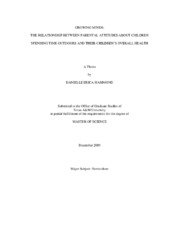| dc.description.abstract | The objective of this study was to investigate the relationship between the attitudes of parents toward outdoor environments and their children spending time outdoors, and how these attitudes related to their children's overall health. The sample for this study consisted of parents of six to thirteen year old children from the U.S., who accessed the survey from the Aggie Horticulture homepage between March and August 2009. Surveys were collected until 142 completed questionnaires were received. The online questionnaire included questions about parents' attitude toward nature; their children playing outdoors, play site rating, and children's overall health and demographic questions.
Descriptive statistics were used to tabulate mean scores on the Parental Attitude About Nature Scale, and Parental Attitude About Their Children Spending Time Outdoors Scale, both of which indicated overall positive views. Pearson's product-moment correlations indicated statistically significant relationships between the Parental Attitude About Nature Scale, and Parental Attitude About Their Children Spending Time Outdoors Scale (P=0.001), and between these two scales and time children spent outdoors (P=0.008, P=0.05). No correlation existed between Parental Attitude About Their Children Spending Time Outdoors score and the Health Problems score (P=0.459). Also, there were statistically significant relationships between time spent indoors on video games or watching TV and health problems of children (r=+0.182, P=0.031), congestion (r=+0.192, P=0.023), and children having trouble sleeping (r=+0.237, P=0.005); asthma attacks and with the time spent in indoor organized sports (r=+0.274, P=0.001) and outdoor organized sports (r=+0.177, P=0.036). Additionally, time spent outdoors in free play was negatively correlated with body pain or discomfort (r=-0.219, P=0.009), repeated upset stomach (r=-0.179, P=0.034), or feeling tired or having low energy (r=-0.289, P=0.001). In regards to play areas a post-hoc analysis (Tukey's HSD) revealed that all the outdoor play scene pictures had statistically significantly higher mean scores in ratings of approval by parents (P=0.001) when compared to the indoor play area and that the outdoor scene picture with the black hardtop surface had a statistically significantly lower mean score (P=0.001) than the other outdoor play scene pictures. This indicated that, in general, parents preferred play areas with a greater amount of natural elements. | en |


